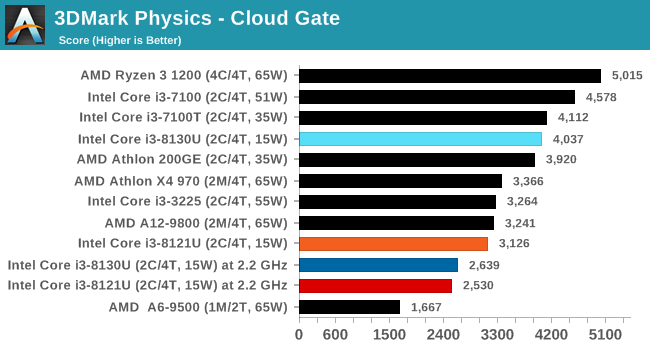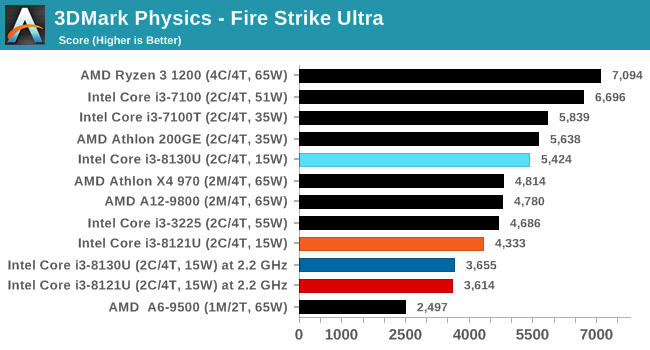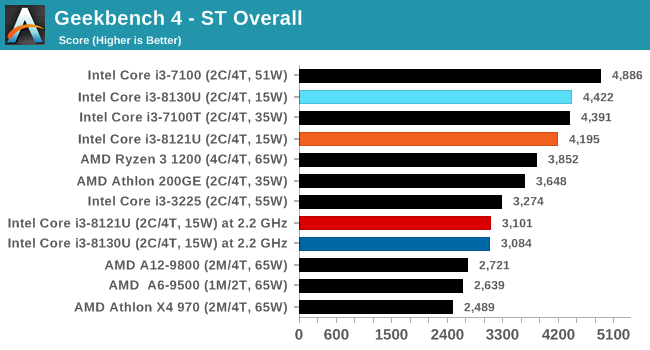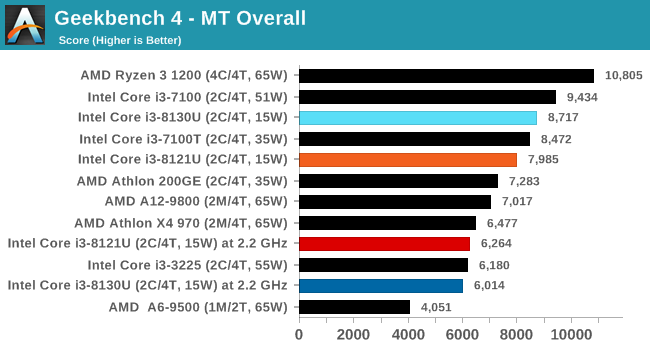Intel's 10nm Cannon Lake and Core i3-8121U Deep Dive Review
by Ian Cutress on January 25, 2019 10:30 AM ESTStock CPU Performance: Office Tests
The Office test suite is designed to focus around more industry standard tests that focus on office workflows, system meetings, some synthetics, but we also bundle compiler performance in with this section. For users that have to evaluate hardware in general, these are usually the benchmarks that most consider.
All of our benchmark results can also be found in our benchmark engine, Bench.
3DMark Physics: In-Game Physics Compute
Alongside PCMark is 3DMark, Futuremark’s (UL’s) gaming test suite. Each gaming tests consists of one or two GPU heavy scenes, along with a physics test that is indicative of when the test was written and the platform it is aimed at. The main overriding tests, in order of complexity, are Ice Storm, Cloud Gate, Sky Diver, Fire Strike, and Time Spy.
Some of the subtests offer variants, such as Ice Storm Unlimited, which is aimed at mobile platforms with an off-screen rendering, or Fire Strike Ultra which is aimed at high-end 4K systems with lots of the added features turned on. Time Spy also currently has an AVX-512 mode (which we may be using in the future).
For our tests, we report in Bench the results from every physics test, but for the sake of the review we keep it to the most demanding of each scene: Ice Storm Unlimited, Cloud Gate, Sky Diver, Fire Strike Ultra, and Time Spy.





In all tests, at fixed frequency, the processors act identical, however at stock frequencies that Kaby Lake chip just has more headroom to push.
GeekBench4: Synthetics
A common tool for cross-platform testing between mobile, PC, and Mac, GeekBench 4 is an ultimate exercise in synthetic testing across a range of algorithms looking for peak throughput. Tests include encryption, compression, fast Fourier transform, memory operations, n-body physics, matrix operations, histogram manipulation, and HTML parsing.
I’m including this test due to popular demand, although the results do come across as overly synthetic, and a lot of users often put a lot of weight behind the test due to the fact that it is compiled across different platforms (although with different compilers).
We record the main subtest scores (Crypto, Integer, Floating Point, Memory) in our benchmark database, but for the review we post the overall single and multi-threaded results.












129 Comments
View All Comments
MrCommunistGen - Friday, January 25, 2019 - link
Normally I try to read the whole article (and I *am* looking forward to reading the rest of it) but I already have 2 comments:1. Maybe this review has been in progress for quite a while, but you can definitely buy the NUC8i3CYSM NUC on Amazon, at least in the US. It is shipped and sold by Amazon not some random 3rd party too. It is expensive ($530), and can only be bought with up to 8GB of soldered down RAM, but you can buy it.
2. While the Wi-Fi card is M.2, Lenovo (like HP and others) usually restricts what Wi-Fi cards can be used with a BIOS/UEFI whitelist. I guess this might not apply to a China-only model, but I wouldn't just assume that the card can be upgraded down the line unless you've already verified this is possible.
jaju123 - Friday, January 25, 2019 - link
I would chalk up the system resonsiveness to the GPU and the low screen res. When moving from a Dell XPS 15 9560 laptop with 1080p screen resolution to an otherwise identical 4K model, I noticed a severe loss of performance in the windows UI. The reality is that Intel iGPUs in even kaby lake processors are simply not enough to provide a smooth experience on high res laptops. The 1080p experience was really smooth, however.You can also force certain apps to the use the dedicated nvidia graphics, or simply choose to run at a non-native 1080p and it speeds up the UI drastically.
hansmuff - Friday, January 25, 2019 - link
Wow, this is an excellent article. Packed with knowledge and facts, well written; a real gem. Thank you!FreckledTrout - Friday, January 25, 2019 - link
Its weird to see a dual core even in a laptop on the new 10nm process. I would have expected dual cores to disappear with Intel's 10nm or AMD's 7nm.FreckledTrout - Friday, January 25, 2019 - link
The first dual core laptop came out in 2015 with the AMD Athlon 64 X2 4800 so it's just weird to me 14 years later it's still something being made especially with such a dense process.FreckledTrout - Friday, January 25, 2019 - link
Damn no edit.... in 2005 I meant.jeremyshaw - Friday, January 25, 2019 - link
I think I had one of those in a Sharp laptop. It had horrible VIA S3 graphics, but a beautiful, bright display. It was my last 4:3 laptop, an end of an era for me.Icehawk - Saturday, January 26, 2019 - link
Majority of laptops are still DC, I have to check our laptop orders when we place them to make sure my boss and our vendor aren’t screwing up ordering them.ianmills - Friday, January 25, 2019 - link
Intel probably thought the same as you! Remember the reason this was released was so that Intel could tell its investors it was shipping 10nm partsdanwat1234 - Friday, January 25, 2019 - link
Agreed.